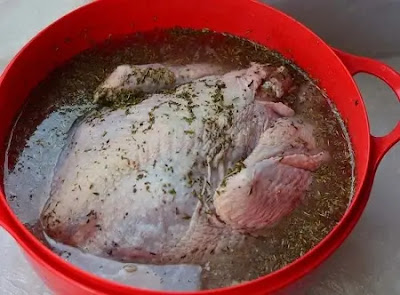Cooking a turkey is an essential part of many holiday feasts, and whether it's your first time or you're a seasoned pro, you know that getting the perfect turkey can be a daunting task. One of the most common challenges is making sure your turkey stays moist and flavorful throughout the cooking process. This is where brining comes in.
Brining is a popular technique used by many chefs and home cooks to create a juicy and tasty turkey. In this article, we'll discuss why brining a turkey is beneficial and how to do it.
First, let's define what brining is. Brining is a process of soaking meat, in this case, a turkey, in a saltwater solution for a period of time before cooking. The brine solution can also include other seasonings and aromatics, such as sugar, herbs, spices, and even fruit juice, to enhance the flavor of the meat.
The science behind brining is simple: the salt in the brine solution breaks down the protein fibers in the turkey, which allows the meat to absorb the moisture and flavors from the solution. As a result, the turkey becomes juicier, more flavorful, and tender.
Now that we've covered the basics of brining, let's dive into the benefits of this technique.
What is Brining?
Brining is a process that has been used for centuries to preserve and flavor meats. It involves soaking the meat in a saltwater solution for a period of time before cooking. But what exactly is happening during the brining process?
When you brine a turkey, you are essentially creating a chemical reaction between the salt in the brine solution and the proteins in the turkey. This reaction causes the protein fibers to break down, allowing them to absorb more liquid and flavors from the brine. In turn, the turkey becomes more moist, tender, and flavorful.
There are two main types of brine solutions: wet brines and dry brines. Wet brines are made by dissolving salt and other seasonings in water, while dry brines involve rubbing a salt and seasoning mixture directly onto the turkey. Both methods work well, but wet brining tends to be more effective for larger birds like turkeys, as it allows for more even distribution of the brine.
When making a wet brine solution, you can customize it to your liking by adding additional ingredients like sugar, herbs, spices, or even fruit juice. These additions can enhance the flavor of the turkey and provide a unique twist to your recipe.
Not all meats are suitable for brining. For example, meats that are already naturally tender and juicy, such as filet mignon or ribeye, may not benefit from brining. However, turkey, which can easily dry out during cooking, is an excellent candidate for brining.
III. Benefits of Brining
Brining is a popular technique for preparing turkey that has several benefits. The process involves soaking the turkey in a saltwater solution for several hours before cooking it. The saltwater solution, or brine, helps to make the turkey more moist, flavorful, and tender. Here are some of the main benefits of brining a turkey:
- Prevents Dryness: One of the primary benefits of brining is that it helps prevent the turkey from becoming dry during cooking. The salt in the brine solution helps the meat to retain moisture, resulting in a juicier and more succulent turkey. This is especially important for the white meat, which can often dry out during cooking.
- Enhances Flavor: Brining can also enhance the flavor of the turkey. The salt in the brine solution helps to infuse the meat with additional flavors, while other ingredients like herbs and spices can provide a unique taste. You can experiment with different flavors to create a turkey that suits your tastes.
- Tenderizes the Meat: Brining can help to tenderize the meat by breaking down the protein fibers in the turkey. This makes it easier to cut and eat, resulting in a more enjoyable dining experience.
- Improves Texture: Brining can also improve the texture of the turkey. The moisture that the meat absorbs from the brine helps to create a more succulent and delicate texture, which makes for a more enjoyable eating experience.
- Customizable: One of the great things about brining is that it is highly customizable. You can experiment with different brine recipes and ingredients to create a turkey that suits your tastes. For example, you can add herbs like thyme and rosemary or spices like cumin and coriander to the brine to create a unique flavor profile.
- Easy and Inexpensive: Brining is a relatively easy and inexpensive technique to use. All you need is a large container or plastic bag, water, salt, and any additional ingredients you want to add to the brine. Compared to other methods like basting, which can be time-consuming and require frequent attention, brining is a relatively hands-off process.
- Can Improve Shelf Life: Brining can also help to improve the shelf life of your turkey. The salt in the brine acts as a preservative, which can help to extend the life of the meat. This is particularly useful if you are planning to cook your turkey ahead of time or if you have leftovers that you want to store for later.
- Reduces Cooking Time: Brining can also help to reduce the cooking time of your turkey. By pre-soaking the meat in a brine solution, you can help to speed up the cooking process and ensure that the turkey cooks more evenly. This is especially useful for larger birds, which can take a long time to cook through.
- Can Help to Mask Mistakes: Brining can also help to mask mistakes that you may have made during the cooking process. For example, if you accidentally overcook your turkey, the moisture from the brine can help to soften the meat and make it more palatable.
- Adds Aesthetic Appeal: Brining can also add aesthetic appeal to your turkey. The salt in the brine solution can help to create a beautiful golden-brown color on the skin of the turkey, which can make it more visually appealing.
- Works for Different Cuts: Brining can be used for different cuts of turkey, not just the whole bird. You can also use it to prepare turkey breasts, thighs, and legs, all of which can benefit from the added moisture and flavor.
Brining is a simple yet effective technique that can help to enhance the flavor, texture, and moisture of your turkey. It is a versatile method that can be customized to suit your tastes, and it can also help to extend the shelf life of your meat.
How to Brine a Turkey
Brining a turkey is a straightforward process that involves soaking the bird in a saltwater solution for several hours. Here is a step-by-step guide on how to brine a turkey:
- Choose your brine: The first step is to choose your brine solution. You can use a basic brine solution of water, salt, and sugar, or you can add additional flavors such as herbs, spices, and citrus fruits. The ratio of salt to water is typically 1 cup of salt per gallon of water, but this can vary depending on your preference and the size of your turkey.
- Prepare your brine: In a large pot, heat up the water and dissolve the salt and sugar into the water. Add any additional flavorings you desire. Once everything is dissolved and combined, let the brine cool to room temperature.
- Clean your turkey: Remove the turkey from its packaging and remove any giblets or neck inside the cavity. Rinse the turkey inside and out under cold water and pat dry with paper towels.
- Soak the turkey: Place the turkey in a large food-safe plastic bag or a large container (such as a stockpot or a bucket). Pour the brine solution over the turkey, making sure that the bird is fully submerged in the liquid. If necessary, add more water to cover the bird completely. Seal the bag or cover the container with a lid or plastic wrap.
- Refrigerate the turkey: Place the bag or container with the turkey and brine solution in the refrigerator for the recommended amount of time. A general rule of thumb is to brine the turkey for 1 hour per pound of meat. For example, if your turkey is 12 pounds, you should brine it for 12 hours. Make sure that the turkey stays below 40°F (4°C) at all times to prevent bacterial growth.
- Rinse and dry the turkey: After the brining time is up, remove the turkey from the brine solution and rinse it thoroughly under cold water to remove any excess salt. Pat the turkey dry with paper towels and let it air dry for about 30 minutes to an hour. This will help the skin to become crispy during cooking.
- Cook the turkey: Once the turkey is dry, you can cook it according to your preferred method. Brining does not affect cooking times or temperatures, so you can use your usual cooking techniques.
There are also different methods for brining a turkey, including wet brining and dry brining. Wet brining involves fully submerging the turkey in a brine solution, as described above. Dry brining involves rubbing the turkey with a salt mixture and letting it sit in the refrigerator for several hours to draw out moisture. Both methods have their pros and cons, so it's important to choose the method that works best for you.
Tips and Tricks for Brining
Brining a turkey can be a daunting task, but with the right tips and tricks, you can achieve a juicy and flavorful bird that your guests will love. Here are some helpful tips and tricks to make your brining experience a success:
- Use a Food-Safe Plastic Bag: When brining your turkey, it's important to use a food-safe plastic bag or a non-reactive container such as a stainless steel pot or a glass dish. Avoid using garbage bags or containers made of aluminum, copper, or cast iron as they can react with the brine and affect the flavor of the turkey.
- Refrigerate the Turkey during Brining: It's important to keep the turkey refrigerated during brining to prevent bacteria growth. A good rule of thumb is to keep the turkey at a temperature of 40°F or below. You can use a large cooler or a refrigerator to keep the turkey chilled.
- Adjust the Brine Solution to Your Taste: Brine solutions can be adjusted to suit personal preferences. If you prefer a sweeter flavor, add more sugar to the brine. If you prefer a more savory flavor, add more herbs and spices. You can also experiment with different types of liquids such as beer, apple cider, or vegetable stock to add more depth to the flavor.
- Consider Injecting the Brine: Another way to ensure that the turkey is evenly brined is by injecting the brine solution into the turkey with a flavor injector. This method is particularly useful for larger turkeys or if you're short on time.
- Avoid Over-Brining: It's important to follow the recommended brining time to avoid over-brining the turkey. Over-brining can result in a turkey that is too salty and has a rubbery texture. A good rule of thumb is to brine the turkey for one hour per pound of meat.
- Dry the Turkey Before Cooking: Before cooking the turkey, it's important to pat it dry with paper towels to remove excess moisture. This will help to ensure that the skin becomes crispy during cooking.
- Don't Forget to Rest the Turkey: After cooking, it's important to let the turkey rest for at least 15 minutes before carving. This will allow the juices to redistribute throughout the meat, resulting in a moist and tender turkey.
By following these tips and tricks, you can ensure that your brining experience is a success and that your turkey is moist, juicy, and flavorful.
👉 Read more posts with the same topic
Conclusion
Brining a turkey is a highly effective technique for achieving a juicy and flavorful bird that will impress your guests. Through this article, we have explored the benefits of brining a turkey, how to do it, and some tips and tricks for success.
Brining not only helps to prevent dryness but also enhances the flavor and tenderness of the meat. By soaking the turkey in a brine solution, the salt and other flavorings penetrate deep into the meat, resulting in a turkey that is moist, tender, and delicious.
To brine a turkey successfully, it's important to use a food-safe plastic bag or non-reactive container, refrigerate the turkey during brining, and adjust the brine solution to your personal taste. Additionally, you can consider injecting the brine solution for even distribution and be careful not to over-brine the turkey.
By following these tips and tricks, you can achieve a perfectly brined turkey that will be the highlight of your holiday feast. So why not give brining a try for your next turkey dinner? Your taste buds and guests will thank you for it!
Brining is a simple yet effective technique that can turn a dry and flavorless turkey into a delicious and juicy feast. It takes a bit of time and effort, but the results are well worth it. So why not try brining your turkey for your next holiday feast and experience the difference for yourself?








0 Comments